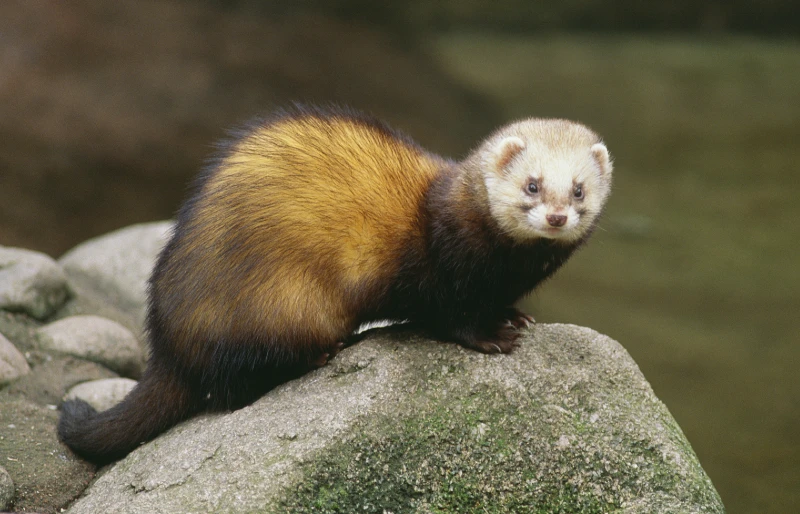Polecat vs Ferret: Key Difference Explained (with Pictures)
Updated on

Click to Skip Ahead
On the surface, polecats and ferrets may look like basically the same animal. In fact, they are very closely related, which is why they are sometimes mistaken as the same species. However, they do have many differences between them.
For instance, polecats tend to be larger and more muscular than ferrets. Ferrets are often very slender with shorter necks, while polecats are bulkier.
Perhaps the biggest difference is that ferrets are legal to own in several countries, including the United States. They are often considered a domestic species. However, polecats are wild animals, and they aren’t widely considered domesticated. Owning one is often illegal in many countries.
Visual Differences

At a Glance
- Average height (adult): 12–15 inches
- Average weight (adult): 2–3 pounds
- Lifespan: 5–8 years
- Exercise: At least 3 hours
- Grooming needs: Low-maintenance
- Family-friendly: No
- Other pet-friendly: No
- Trainability: Some
- Average height (adult): 10–13 inches
- Average weight (adult): 1–4 pounds
- Lifespan: 7–10 years
- Exercise: At least 2 hours
- Grooming needs: Low-maintenance
- Family-friendly: If socialized
- Other pet-friendly: If socialized
- Trainability: Moderate
Polecat Overview
Appearance
Polecats are pretty big when compared to a ferret. They can weigh nearly three times as much in some cases, though they pack their weight into a similarly sized frame. They’re quite muscular, with a longer neck and narrow head. Therefore, they are often also considered stronger than ferrets, which can be an issue for those interested in owning one of these wild animals as a pet.
They usually have thick fur that comes in dark brown or black. Luckily, they’ve evolved to completely take care of this coat by themselves in the wild, so they wouldn’t require any grooming when kept as a pet. However, they do shed considerably.

Behavior
As wild animals, polecats are unpredictable and not tame. They are illegal to own as pets in many cases for this reason. They may look like ferrets, but they are absolutely not ferrets. They will bite and scratch in many cases, even when kept around humans since birth.
Polecats need a lot of space to exercise and explore. They should not be kept in a small cage or enclosure. You’ll often need to dedicate a large area to these animals, which makes them more suitable for life at a wildlife facility or in the wild where they belong. They are not social animals, unlike ferrets. Therefore, they do not naturally learn to get along with others and cannot be kept in a group. They are not very friendly and are more likely to see others entering their space as threats.
In addition to these differences, polecats also have a stronger musky odor than ferrets. This odor can be quite pungent, and it can be difficult to remove. Polecats are also more likely to spray this odor when they are feeling threatened or stressed.
They also don’t respond to training. They aren’t tame animals, after all. Some may be able to learn some basic tricks, but they aren’t nearly as obedient as ferrets or other domestic animals.
Ferret Overview
Appearance
Ferrets are a bit smaller than a polecat. They can be a bit longer than a polecat, though. However, they are often much slenderer and have less muscle mass, which leads to them weighing less overall. Usually, ferrets only reach a maximum of 4 pounds. Ferrets also have smaller, narrower heads. Their snout is less pronounced, and their face may seem smaller overall.
Thanks to careful breeding by humans, ferrets come in a range of different colors. You can find them in black, white, brown, and cream. On the other hand, polecats only come in dark brown or black. You’ll find a much wider range of coat colors amongst ferrets, especially if you’re willing to pay for more rarer coat colorations.

Behavior
Ferrets are domesticated. Therefore, they are much more responsive to humans and can do well in captivity. Humans have been breeding ferrets for generations to help them adapt better to living alongside people. Therefore, they have lost some of their wildness and are much tamer than polecats.
They are social animals and like living in groups. It’s often recommended that prospective owners purchase two or more ferrets. They like to have someone that will keep them company for much of the day. Their socialization needs can be hard for their owner to fulfill alone, hence why getting two is recommended.
Ferrets are generally more docile than polecats. They’ve been bred to live alongside people, and it shows. They are just as tame and domesticated as a cat or dog at this point.
It is important to note that there are also some polecat-ferret hybrids. These animals are the result of cross-breeding between a wild polecat and a domesticated ferret. Hybrids can exhibit a variety of characteristics, depending on the genetics of their parents. Often, these animals aren’t particularly tame and can instead be quite wild and prone to biting. Therefore, we don’t recommend purchasing one of these hybrid animals.
Are Ferrets and Polecats the Same?
Ferrets and polecats are not the same, but they are closely related animals.
Ferrets (Mustela putorius furo) are domesticated descendants of the European polecat (Mustela putorius). Ferrets have been bred and domesticated for various purposes, including hunting, pest control, and as pets. They come in various colors and have a more docile temperament compared to their wild polecat ancestors.
That said, polecats are still found in the wild in various parts of Europe and Asia. They are part of the same family as ferrets, making them very closely related. However, polecats are often larger and more aggressive. They are wild animals, unlike their domesticated cousins.
Domestic ferrets have been bred for specific traits over generations to make them more suitable as pets or working animals, whereas polecats remain wild animals with their natural behaviors intact.

How Do You Differentiate a Polecat from a Ferret?
Telling these two species apart can be challenging, as they are very closely related. The size can often be a helpful indicator. Polecats are often bigger and more muscular than ferrets. Ferrets are often slimmer and weigh less. Polecats have a fairly bushy tail, as well, and they almost always have a dark tip. A ferret’s tail can vary widely and is comparably less bushy than a polecat’s tail.
Polecats have a dark brown to black coat with a distinctive white face mask. Domestic ferrets come in a variety of colors, including albino (white with pink eyes), sable (dark brown with a mask), and other color variations. Some ferrets may have a similar coloration to polecats, but they lack the distinctive face mask.
If you see a ferret-like animal that isn’t a dark color, it is probably a domestic ferret—not a polecat.
Of course, polecats are also wild animals. Therefore, they tend to be aggressive and more elusive. They will not just walk up to a human. In fact, they’re known for being a bit territorial. Ferrets that were kept as pets may be docile and friendlier. They may approach humans, especially if they are hungry.
Which One Is Right for You?
Ferrets are domesticated, and polecats are not. Therefore, you can only legally own a ferret. Plus, ferrets have much more human-friendly traits than polecats do, as they have been carefully bred over generations. On the other hand, polecats are likely to bite and scratch humans, even when socialized with them.
Therefore, ferrets are easily the better option for the vast majority of families.
Featured Image Credit: Left – ajwetton, Pixabay | Right – ambquinn, Pixabay










